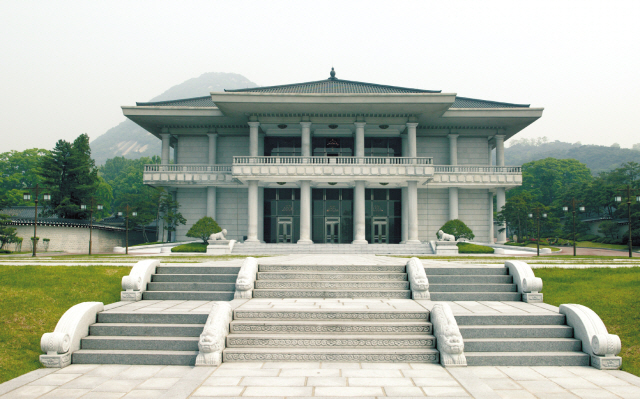Presidential house boasts many landmarks
Sangchunjae bears the essence of Korean house’s architectural tradition and beauty.
By Korea HeraldPublished : Jan. 4, 2013 - 20:30

Cheong Wa Dae boasts a variety of historical buildings and monuments to interest foreign and local visitors.
Among them is Chunchugwan, the two-story press center where presidential secretaries and spokespeople communicate with journalists. It can accommodate more than 300 people.
The center is also where the president delivers nationally televised addresses. Its first floor consists of a press room, archives and a small briefing room for journalists. The second floor hosts a large briefing room where the president holds press conferences.
The name originates from one of the Five Confucian Classics, titled Chunchu in Korean pronunciation, meaning the Spring and Autumn Annals. The book emphasizes fair criticism and strict objectivity in the recording of history. The name was repeatedly used for offices of historical compilation throughout the Goryeo and Joseon Dynasties.
Another landmark building is Sangchunjae. It is a presidential venue for unofficial meetings and dinners with small groups of international dignitaries. Sangchunjae means “ever spring house.” As it bears the essence of Korea’s architectural tradition and beauty, the house has been primarily used to serve guests from overseas.
Among them is Chunchugwan, the two-story press center where presidential secretaries and spokespeople communicate with journalists. It can accommodate more than 300 people.
The center is also where the president delivers nationally televised addresses. Its first floor consists of a press room, archives and a small briefing room for journalists. The second floor hosts a large briefing room where the president holds press conferences.
The name originates from one of the Five Confucian Classics, titled Chunchu in Korean pronunciation, meaning the Spring and Autumn Annals. The book emphasizes fair criticism and strict objectivity in the recording of history. The name was repeatedly used for offices of historical compilation throughout the Goryeo and Joseon Dynasties.
Another landmark building is Sangchunjae. It is a presidential venue for unofficial meetings and dinners with small groups of international dignitaries. Sangchunjae means “ever spring house.” As it bears the essence of Korea’s architectural tradition and beauty, the house has been primarily used to serve guests from overseas.

The structure features “ondol,” Korea’s traditional floor heating system. It was built using the best wooden material including Geumgang red pines aged over 200 years.
During Japan’s colonial occupation, there was a reception facility in the site, which was attached to the Japanese governor’s residence. Korea’s first President Syngman Rhee named it “Sangchunsil (ever spring room),” which was later renovated and gained the current name, “Sangchunjae.”
Nokjiwon is another high-profile presidential site. It is a garden with a large grass field where the presidential office holds receptions for foreign and domestic dignitaries, and other special guests. It became widely known to the public in 1995 when Cheong Wa Dae invited some 3,000 citizens there for a nationally televised concert.
Special occasions such as Children’s Day and Parents’ Day are celebrated there. The garden also serves as a venue for press conferences when world leaders visit the presidential complex.
During the Joseon Dynasty, Nokjiwon was part of the back garden of the Gyeongbok Palace, the main royal residence. During Japan’s colonial occupation, the current site was used for livestock and greenhouse farming. A 160-year-old, 17-meter-high pine tree is a major attraction of the garden.
Also among the landmark architectures is Yeongbin-gwan, a building that houses a reception hall for large-scale official events such as gala dinners for visiting foreign leaders and their entourages.
Its interior walls feature majestic patterns of Korea’s national flower the Mugungwha, and laurels. The architecture has a grandiose facade with 18 stone pillars propping up a traditional roof. On the first floor is a reception room while on the second floor is a gala event hall.
By Lee Sang-ju (sjlee370@heraldcorp.com)
-
Articles by Korea Herald










![[KH Explains] Naver’s Line dilemma: Lose global footing for cash?](http://res.heraldm.com/phpwas/restmb_idxmake.php?idx=644&simg=/content/image/2024/05/14/20240514050624_0.jpg&u=)
![[Herald Interview] Carbon breakthrough in Korea: Making diamonds at atmospheric pressure](http://res.heraldm.com/phpwas/restmb_idxmake.php?idx=644&simg=/content/image/2024/05/14/20240514050559_0.jpg&u=20240514184059)







